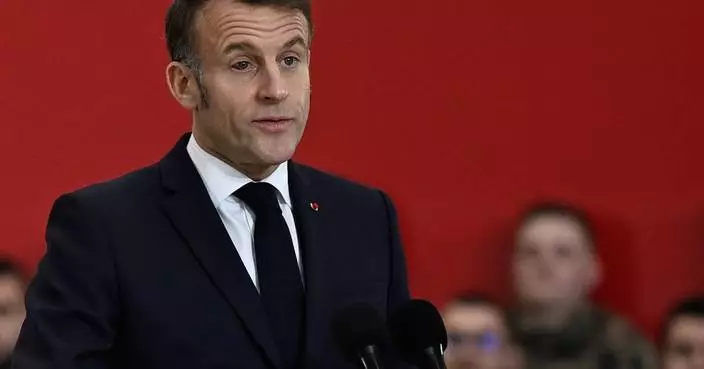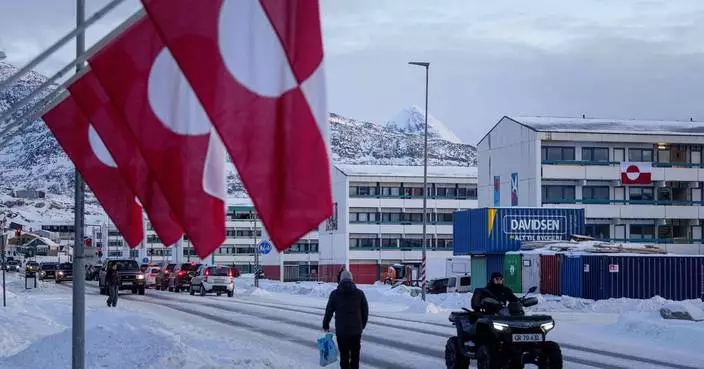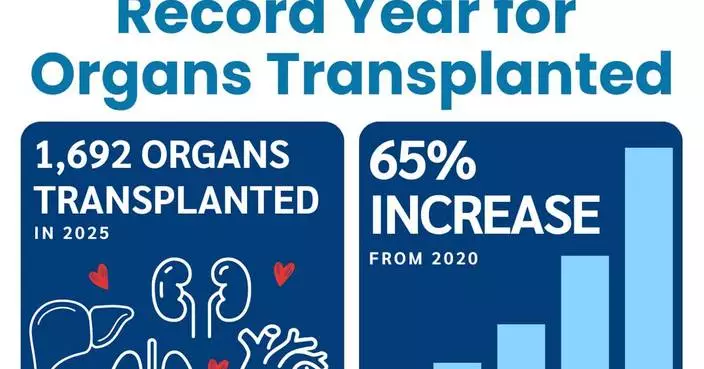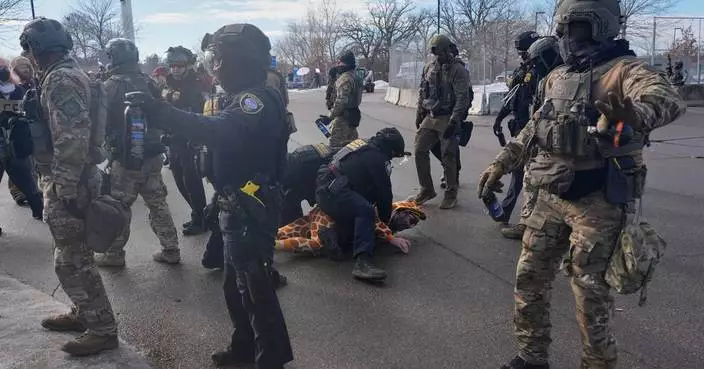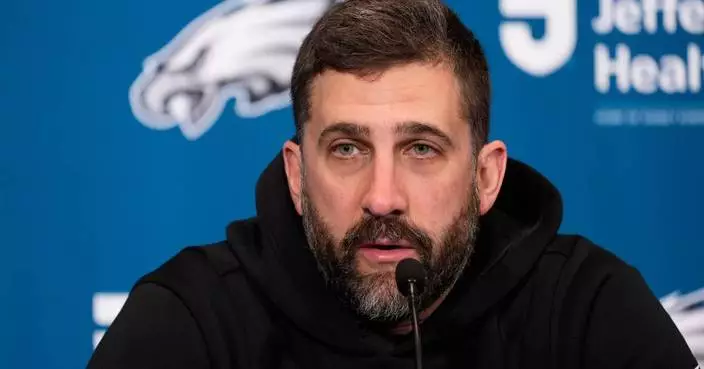Every day, South Korea's Unification Ministry sends officials to the border village of Panmunjom to call North Korea at 9 a.m. and 4 p.m. For more than 18 months, the North hasn't picked up.
As North Korea steps up its weapons tests and threats, the Unification Ministry, dedicated to improving relations with the North and eventual peaceful reunification, faces an almost existential crisis.
Click to Gallery
FILE - This undated file photo distributed by the North Korean government shows what was said to be the test launch of an intermediate range Hwasong-12 in North Korea. (Korean Central News Agency/Korea News Service via AP, File)
FILE - In this June 17, 2005 file photo provided by South Korea Unification Ministry, then South Korean Unification Minister Chung Dong-young, left, poses with then North Korean leader Kim Jong Il in Pyongyang, North Korea. (South Korea Unification Ministry via AP, File)
FILE - This undated file photo distributed on Sept. 3, 2017, by the North Korean government, shows North Korean leader Kim Jong Un, second from right, at an undisclosed location in North Korea. (Korean Central News Agency/Korea News Service via AP, File)
FILE - In this June 13, 2000, file photo, then North Korean leader Kim Jong Il, left, and then South Korean President Kim Dae-jung shake hands in Pyongyang, North Korea. (Yonhap Pool Photo via AP, File)
In this photo provided by South Korea Defense Ministry, South Korea's Hyunmoo II ballistic missile is fired during an exercise at an undisclosed location in South Korea, Monday, Sept. 4, 2017. (South Korea Defense Ministry via AP)
FILE - In this May 10, 2017, file photo, South Korean President Moon Jae-in waves to supporters upon his arrival outside the presidential Blue House in Seoul, South Korea. (AP Photo/Lee Jin-man, File)
Not too long ago the ministry was one of Seoul's most powerful departments. It had central roles in engineering two historic summits between the leaders of the two Koreas and launching joint economic projects in the 2000s. That is mostly gone after nearly a decade of hard-line conservative rule in the South, and a rapid expansion of missile and nuclear weapons development in the North.

FILE - This undated file photo distributed by the North Korean government shows what was said to be the test launch of an intermediate range Hwasong-12 in North Korea. (Korean Central News Agency/Korea News Service via AP, File)
The nuclear problem has become much larger than just a Korean Peninsula issue. North Korea has launched midrange missiles over Japan and flight-tested intercontinental ballistic missiles, confirming fears that it's close to its goal of building a military arsenal that can target the United States and its Asian allies.
The world has responded by stepping up sanctions and military pressure on Pyongyang. In South Korea, the most important decisions on North Korea now come from the president's office and the defense and foreign ministries. The Unification Ministry has been mostly left to issuing boilerplate denouncements of Pyongyang's weapons tests and propaganda outbursts.
"You need both hands to clap and North Korea isn't responding at all," said Baik Tae-hyun, the ministry's spokesman. "But it won't be like this forever. There were times in the past when it took a long time, a year or two, for relations to thaw after periods of animosity."
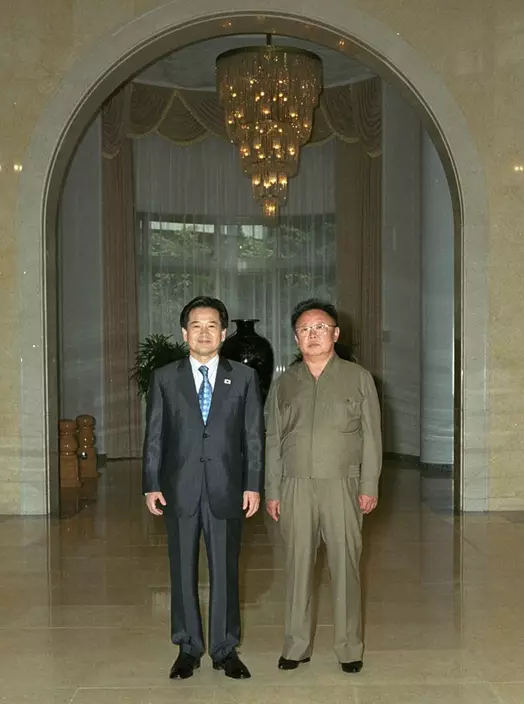
FILE - In this June 17, 2005 file photo provided by South Korea Unification Ministry, then South Korean Unification Minister Chung Dong-young, left, poses with then North Korean leader Kim Jong Il in Pyongyang, North Korea. (South Korea Unification Ministry via AP, File)
The election of a liberal president in May, ending nine years of conservative government, briefly raised hopes. But Pyongyang has so far ignored a Unification Ministry proposal in July to hold inter-Korean military and Red Cross talks. In changed circumstances, it is less clear what the Unification Ministry should, or can do.
DASHED HOPES
The ministry has its origins in the National Unification Board, which opened in 1969 when South Korea was ruled by the staunch anti-communist dictator Park Chung-hee. After mostly serving research functions, it became more prominent under Roh Tae-woo, who won the 1987 presidential vote that took place months after military leaders accepted free elections.
Roh sought to improve relations with Pyongyang following the fall of the Berlin Wall. He elevated the unification board to the level of a vice prime-ministerial department. The Koreas held their first-ever prime ministers' talks in 1990, and both countries joined the United Nations at the same time in 1991.
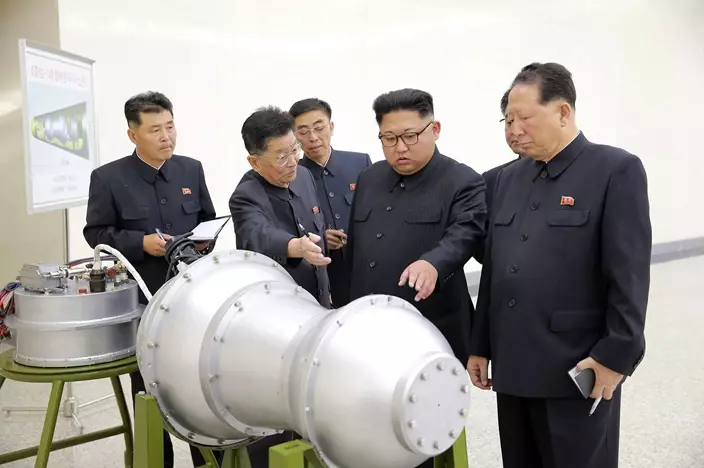
FILE - This undated file photo distributed on Sept. 3, 2017, by the North Korean government, shows North Korean leader Kim Jong Un, second from right, at an undisclosed location in North Korea. (Korean Central News Agency/Korea News Service via AP, File)
Two liberal presidents, Kim Dae-jung and Roh Moo-hyun, met with North Korea's then-leader Kim Jong Il in 2000 and 2007, respectively. But his son, current leader Kim Jong Un, has conducted four of the country's six nuclear tests and seems to see no value in dealing with Seoul.
Successive conservative governments in South Korea, from 2008 until earlier this year, took a tough line on Pyongyang's nuclear ambitions, erasing past reconciliatory efforts.
The five-year presidency of President Lee Myung-bak, who took office in early 2008, was marked by animosity with the North, including North Korean attacks on a warship and a border island that together killed 50 South Koreans in 2010. He briefly considered closing the Unification Ministry and transferring its functions to the Foreign Ministry.
His successor, conservative Park Geun-hye, angered Pyongyang by openly talking about a potential regime collapse in the North. She took an even harder line last year as North Korea conducted two nuclear tests.
Her government pulled South Korean companies out of an industrial park in North Korea's Kaesong in February 2016, the last remaining major symbol of cooperation between the two. One of Park's unification ministers became so frustrated that he reportedly said his job could be given to anyone because it wouldn't make a difference. The ex-minister, Ryoo Kihl-jae, declined to comment for this story.
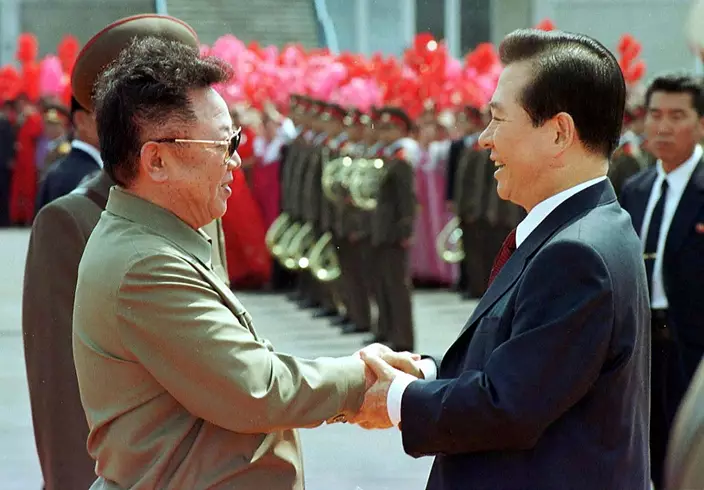
FILE - In this June 13, 2000, file photo, then North Korean leader Kim Jong Il, left, and then South Korean President Kim Dae-jung shake hands in Pyongyang, North Korea. (Yonhap Pool Photo via AP, File)
It's still critical that the Unification Ministry keeps knocking on the North's door, said Jeong Se-hyun, who served as unification minister under liberals Kim Dae-jung and Roh Moo-hyun
"The ministry has to keep pestering Pyongyang over the military and Red Cross talks," he said. "It has to keep placing calls on the Panmunjom telephone. The situation can quickly change and North Korea could feel the need for dialogue. When they do return, they will likely want to deal with the United States first, but let them try to accomplish anything in talks with Washington without the involvement of Seoul — it won't work."
DRIVER'S SEAT TO BACKSEAT
A liberal returned to power in South Korea in May, after a corruption scandal forced Park from office.
President Moon Jae-in harshly criticized the approach of his conservative predecessors, who he said did nothing to stop Pyongyang's nuclear advances and diminished Seoul's voice in international efforts to deal with the North.
He made longtime ministry official Cho Myoung-gyun his unification minister, valuing his experience in preparations for the two summits, including accompanying Roh to the 2007 meeting with Kim Jong Il. He expressed hope that the resumption of inter-Korean talks would help put Seoul in the "driver's seat."
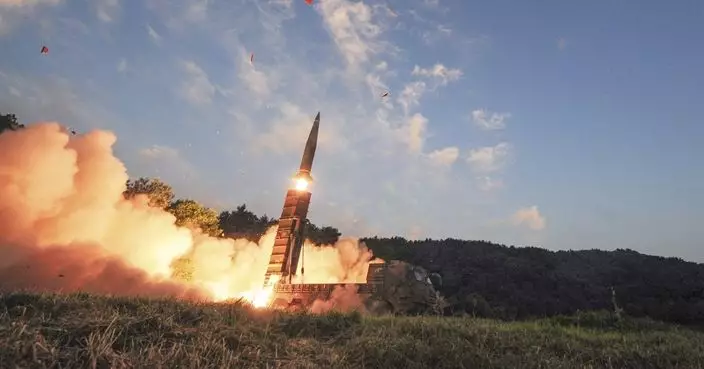
In this photo provided by South Korea Defense Ministry, South Korea's Hyunmoo II ballistic missile is fired during an exercise at an undisclosed location in South Korea, Monday, Sept. 4, 2017. (South Korea Defense Ministry via AP)
North Korea's only response has been more missile launches and its sixth nuclear test. Moon is now scrambling to ramp up the South's military capabilities, saying dialogue is currently "impossible" after North Korea's most powerful nuclear test ever on Sept. 3.
Some experts say the stakes have become too high for the reins to remain with Seoul. The belief that improvements in inter-Korean relations alone could lead to meaningful breakthroughs over the nuclear problem are outdated views from a time when the North's threat was weak, said Hong Min, an analyst at the Korea Institute for National Unification in Seoul
"Seoul needs to move with the international community to deal with the challenge posed by North Korea's nuclear missiles, instead of approaching it as a matter of who gets to lead," he said.
Chung Dong-young, a lawmaker who served as unification minister under Roh Moo-hyun, disagrees, saying Seoul should still try to lead the process and push harder to resume talks with Pyongyang.

FILE - In this May 10, 2017, file photo, South Korean President Moon Jae-in waves to supporters upon his arrival outside the presidential Blue House in Seoul, South Korea. (AP Photo/Lee Jin-man, File)
As Seoul's special envoy, Chung went to Pyongyang in June 2005 to meet with Kim Jong Il and try to persuade him to return to multilateral negotiations on North Korea's then-nascent nuclear program. The North months earlier had declared it would no longer attend the six-party talks by the Koreas, the United States, China, and Russia that had been launched in 2003.
The June meeting helped set up North Korea's return to talks three months later in Beijing, where it agreed to end its nuclear weapons program in return for security and energy benefits.
"That was when South Korea was actually in the driver's seat," Chung said.
The six-party agreement of September 2005 foundered quickly, and the North detonated its first nuclear device in October 2006.
The U.N. Security Council in an emergency meeting Thursday discussed Iran's deadly protests at the request of the United States, even as President Donald Trump left unclear what actions he would take against the Islamic Republic.
Tehran appeared to make conciliatory statements in the lead up to the meeting in an effort to defuse the situation after Trump threatened to take action to stop further killing of protesters, including the execution of anyone detained in Tehran’s bloody crackdown on nationwide protests.
Iran’s crackdown on the demonstrations has killed at least 2,677, the U.S.-based Human Rights Activists News Agency reported. The death toll exceeds any other round of protest or unrest in Iran in decades and recalls the chaos surrounding the country’s 1979 Islamic Revolution.
The sound of gunfire faded Thursday in the capital, Tehran, and witnesses said bonfires and street debris were not visible like they had been in past mornings. Video footage of demonstrations also has stopped appearing, likely signaling the protests have slowed under the heavy security presence in major cities.
Here is the latest:
New Zealand has “temporarily” closed its embassy in Tehran, Iran, and moved consular operations to Ankara, Turkey, officials in Wellington said Friday.
All New Zealand diplomatic staff left Iran on commercial flights during the past day, New Zealand’s foreign ministry said in a statement. The move followed remarks Thursday by Foreign Minister Winston Peters, who said his government was “appalled by the escalation of violence and repression” in Iran.
“We condemn the brutal crackdown being carried out by Iran’s security forces, including the killing of protesters,” Peters posted on X.
The foreign ministry repeated official advice Friday that New Zealanders should avoid travel to Iran and “leave now” if they were already there. They said the ability of New Zealand’s government to provide consular help to the country’s citizens in Iran was “extremely limited.”
France’s U.N. Ambassador Jérôme Bonnafont said that “given the scale and brutality of the repression” against protesters, the international community must denounce the violence.
He reiterated France’s call for the immediate release of all those arbitrarily detained and suspension of the death penalty and called for the rapid convening of a special session of the Geneva-based U.N. Human Rights Council to address the situation in Iran and investigate rights violations.
Britain’s deputy ambassador Archibald Young condemned Iran’s actions “in the strongest possible terms” and paid tribute “to the courage of the Iranian people, particularly Iranian women.”
The United Kingdom has told Iran’s foreign minister that “Iran must urgently change course” and respect the fundamental rights of Iranians, “including the right to protest without fear of violence or repression.”
If it doesn’t, Young said the Group of Seven major industrialized nations, including the U.K., has made clear that it will impose additional sanctions.
“The world is watching,” he said.
Gholam Hossein Darzi, the deputy Iranian ambassador to the U.N., blasted the U.S. for what it claims is American “direct involvement in steering unrest in Iran to violence.”
“Under the hollow pretext of concern for the Iranian people and claims of support for human rights, the United States is attempting to portray itself as a friend of the Iranian people — while simultaneously laying the groundwork for political destabilization and military intervention under a so-called ‘humanitarian’ narrative,” Darzi said during his statement.
The Iranian official also called out U.S. for what it described as its own human rights abuses against protesters with the recent killing of Renee Good in Minnesota by a U.S. Immigration and Customs Enforcement officer.
Russia’s U.N. Ambassador Vassily Nebenzia told an emergency meeting of the U.N. Security Council that Moscow stands in solidary with Iran and backs its view that “hostile external forcers are attempting to exploit the current situation in order to overthrow a government they find objectionable and destroy the Islamic Republic of Iran as a sovereign and independent state.”
Russia called on the U.S. “to stop making themselves out to be a global judge and put an end to their escalatory actions,” he said. Moscow also called on the U.N.’s 193 member nations “to prevent a new large-scale escalation.”
Nebenzia said U.S. actions “risk plunging the region into even bloodier chaos — chaos that could easily spill beyond its borders.”
He said what happened on Iranian streets in recent days went far beyond peaceful protests, pointing to the use of firearms, the killing of civilians and law enforcement officers and arson attacks on medical facilities and public institutions.
U.S. Ambassador to the U.N. Mike Waltz told an emergency meeting of the U.N. Security Council called by the United States that “The people of Iran are demanding their freedom like never before in the Islamic Republic’s brutal history.”
He said the U.S. message is clear: “President Donald J. Trump and the United States of America stand by the brave people of Iran.”
“President Trump is a man of action, not endless talk like we see at the United Nations,” Waltz said. “He has made it clear, all options are on the table to stop the slaughter, and no one should know that better than the leadership of the Iranian regime.”
Waltz dismissed Iranian allegations that the protests are “a foreign plot” and precursor to military action saying: “Everyone in the world needs to know that the regime is weaker than ever before, and therefore is putting forward this lie because of the power of the Iranian people in the streets.”
“They are afraid,” he said. “They are afraid of their own people.”
Iranian-American activist Masih Alinejad told an emergency meeting of the U.N. Security Council that the Islamic Republic is behaving like the Islamic State militant group, “and deserves to be treated like" the group.
She said: “That is how you save innocent lives.”
She warned that “brutal slaughter” in Iran will get much worse if the world doesn’t take “serious action.”
Alinejad said all Iranians are united in seeking freedom and in the face of Iranian military weapons they want action, not “empty words and empty condemnations.”
The U.N. warns possible military strikes on Iran would add “volatility to an already combustible situation” in an emergency meeting of the U.N. Security Council Thursday.
U.N. Secretary-General António Guterres “urges maximum restraint at this sensitive moment and calls on all actors to refrain from any actions that could lead to further loss of life or ignite a wider regional escalation,” Assistant Secretary-General Martha Pobee said at the meeting.
Guterres urges maximum restraint and remains convinced that all issues regarding Iran, including its nuclear program, should be addressed through diplomacy and dialogue, she said.
The U.N. chief reaffirms the U.N. Charter’s principles that disputes must be settled peacefully and prohibit the threat or use of force, Pobee said.
Masih Alinejad, one of the most vocal Iranian dissidents in the U.S., accused the United Nations and the Security Council of failing “to respond with the urgency this moment demands” at the emergency U.N. Security Council meeting Thursday.
In October, two purported Russian mobsters were each sentenced to 25 years behind bars for hiring a hitman to kill Alinejad at her Brooklyn home on behalf of the Iranian government.
Sitting across the table from the Iranian ambassador to the U.N., Alinejad, who came after an invitation from the U.S., said that “the members of this body have forgotten the privilege and responsibility of sitting in this room.”
In a stunning moment, even for Security Council standards, Alinejad addressed the Islamic Republic’s representative seated at the council directly.
“You have tried to kill me three times. I have seen my would-be assassin with my own eyes in front of my garden, in my home in Brooklyn,” she said while the Iranian official looked directly ahead, without acknowledging her.
Ahead of the emergency U.N. Security Council meeting Thursday, Iranian Foreign Minister Abbas Araghchi and Secretary-General António Guterres
spoke by phone to discuss the recent deadly protests and Iran’s request for the world body to do more to condemn what they call foreign influence in the Islamic Republic, according to a readout of the call posted on Iranian state TV.
The semiofficial Tasnim news agency reported that Araghchi implored the top U.N. official to live up to the “serious expectation” that Iran’s government and its people have of the U.N.s’ role in condemning what the officials called “illegal U.S. interventions against Iran.”
White House press secretary Karoline Leavitt said that U.S. President Donald Trump and his team had communicated to Iranian officials that there would be “grave consequences” if killing continues against protesters in Iran.
“The president understands today that 800 executions that were scheduled and supposed to take place yesterday, were halted,” she said.
But Trump continues closely watching the situation, she said.
“All options remain on the table for the president,” Leavitt said.
Abdul Malik al-Houthi, leader of the Iran-backed Yemeni rebel group, said on Thursday that “criminal gangs” were responsible for the situation in Iran, accusing them of carrying out an “American-Israeli” scheme.
“Criminal gangs in Iran killed Iranian citizens, security forces and burned mosques,” he said without providing evidence. “What’s being committed by criminal gangs in Iran is horrific, bearing an American stamp as it includes slaughter and burning some people alive.”
He also said that the U.S. imposed economic sanctions on Iran to create a crisis leading to the current issues in the country with the end goal of controlling Iran.
Yet he said the U.S. has “failed in Iran” and that Iranians “will not yield to America.”
The president of the European Union’s executive arm says the 27-member bloc is looking to strengthen sanctions against Iran as ordinary Iranians continue their protests against Iran’s theocratic government.
Commission President Ursula von der Leyen said Thursday following a meeting of the EU’s commissioners in Limassol, Cyprus that current sanctions against Iran are “weakening the regime.”
Von der Leyen said that the EU is looking to sanction individual Iranians —apart from those who belong to Iran’s Islamic Revolutionary Guard — who “are responsible for the atrocities.”
She added that the people of Iran who are “bravely fighting for a change” have the EU’s “full political support.”
Canada’s foreign minister says a Canadian citizen has died in Iran “at the hands of the Iranian authorities.”
“Peaceful protests by the Iranian people — asking that their voices be heard in the face of the Iranian regime’s repression and ongoing human rights violations — has led the regime to flagrantly disregard human life,” Canadian Foreign Affairs Minister Anita Anand posted on social media Thursday.
“This violence must end. Canada condemns and calls for an immediate end to the Iranian regime’s violence,” she added.
Anand said consular officials are in contact with the victim’s family in Canada. She did not provide details.
The International Federation of Red Cross and Red Crescent Societies announced Thursday that a local staff member was killed and several others were wounded during the deadly protests in Iran over the weekend.
Amir Ali Latifi, an Iranian Red Crescent Society worker, was working in the country’s Gillan province on Jan. 10 when he was killed “in the line of duty,” the organization said in a statement.
“The IFRC is deeply concerned about the consequences of the ongoing unrest on the people of Iran and is closely monitoring the situation in coordination with the Iranian Red Crescent Society,” the statement continued.
U.S. President Donald Trump has hailed as “good news” reports that the death sentence has been lifted for an Iranian shopkeeper arrested in a violent crackdown on protests.
Relatives of 26-year-old Erfan Soltani had said he faced imminent execution.
Trump posed Thursday on his Truth Social site: “FoxNews: ‘Iranian protester will no longer be sentenced to death after President Trump’s warnings. Likewise others.’ This is good news. Hopefully, it will continue!”
Iranian state media denied Soltani had been condemned to death. Iranian judicial authorities said Soltani was being held in a detention facility outside of the capital. Alongside other protesters, he has been accused of “propaganda activities against the regime,” state media said.
Trump sent tensions soaring this week by pledging that “help is on its way” to Iranian protesters and urging them to continue demonstrating against authorities in the Islamic Republic.
On Wednesday Trump signaled a possible de-escalation, saying he had been told that “the killing in Iran is stopping.”
In a joint statement, the foreign ministers of Canada, France, Germany, Italy, Japan, the United Kingdom, the United States and the European Union’s main foreign policy chief said the G7 members were “gravely concerned” by the developments surrounding the protests, and that they “strongly oppose the intensification of the Iranian authorities’ brutal repression of the Iranian people.”
The statement, published on the EU’s website Thursday, said the G7 were “deeply alarmed at the high level of reported deaths and injuries” and condemned “the deliberate use of violence” by Iranian security forces against protesters.
The G7 members “remain prepared to impose additional restrictive measures if Iran continues to crack down on protests and dissent in violation of international human rights obligations,” the statement said.
China’s Foreign Minister Wang Yi has spoken with his counterpart in Iran, who said the situation was “now stable,” China’s Ministry of Foreign Affairs said.
Abbas Araghchi said “he hoped China will play a greater role in regional peace and stability” during the talks, according to the statement from the ministry.
“China opposes imposing its will on other countries, and opposes a return to the ‘law of the jungle’,” Wang said.
“China believes that the Iranian government and people will unite, overcome difficulties, maintain national stability, and safeguard their legitimate rights and interests,” he added. “China hopes all parties will cherish peace, exercise restraint, and resolve differences through dialogue. China is willing to play a constructive role in this regard.”
“We are against military intervention in Iran,” Turkish Foreign Minister Hakan Fidan told journalists in Istanbul on Thursday. “Iran must address its own internal problems… They must address their problems with the region and in global terms through diplomacy so that certain structural problems that cause economic problems can be addressed.”
Ankara and Tehran enjoy warm relations despite often holding divergent interests in the region.
Fidan said the unrest in Iran was rooted in economic conditions caused by sanctions, rather than ideological opposition to the government.
Iranians have been largely absent from an annual pilgrimage to Baghdad, Iraq, to commemorate the death of Imam Musa al-Kadhim, one of the twelve Shiite imams.
Many Iranian pilgrims typically make the journey every year for the annual religious rituals.
Streets across Baghdad were crowded with pilgrims Thursday. Most had arrived on foot from central and southern provinces of Iraq, heading toward the shrine of Imam al-Kadhim in the Kadhimiya district in northern Baghdad,
Adel Zaidan, who owns a hotel near the shrine, said the number of Iranian visitors this year compared to previous years was very small. Other residents agreed.
“This visit is different from previous ones. It lacks the large numbers of Iranian pilgrims, especially in terms of providing food and accommodation,” said Haider Al-Obaidi.
Europe’s largest airline group said Thursday it would halt night flights to and from Tel Aviv and Jordan's capital Amman for five days, citing security concerns as fears grow that unrest in Iran could spiral into wider regional violence.
Lufthansa — which operates Swiss, Austrian Airlines, Brussels Airlines and Eurowings — said flights would run only during daytime hours from Thursday through Monday “due to the current situation in the Middle East.” It said the change would ensure its staff — which includes unionized cabin crews and pilots -- would not be required to stay overnight in the region.
The airline group also said its planes would bypass Iranian and Iraqi airspace, key corridors for air travel between the Middle East and Asia.
Iran closed its airspace to commercial flights for several hours early Thursday without explanation.
A spokesperson for Israel’s Airport Authority, which oversees Tel Aviv’s Ben Gurion Airport, said the airport was operating as usual.
Iranian state media has denied claims that a young man arrested during Iran’s recent protests was condemned to death. The statement from Iran’s judicial authorities on Thursday contradicted what it said were “opposition media abroad” which claimed the young man had been quickly sentenced to death during a violent crackdown on anti-government protests in the country.
State television didn’t immediately give any details beyond his name, Erfan Soltani. Iranian judicial authorities said Soltani was being held in a detention facility outside of the capital. Alongside other protesters, he has been accused of “propaganda activities against the regime,” state media said.
New Zealand’s Foreign Minister Winston Peters said Thursday that his government was “appalled by the escalation of violence and repression” in Iran.
“We condemn the brutal crackdown being carried out by Iran’s security forces, including the killing of protesters,” Peters posted on X.
“Iranians have the right to peaceful protest, freedom of expression, and access to information – and that right is currently being brutally repressed,” he said.
Peters said his government had expressed serious concerns to the Iranian Embassy in Wellington.
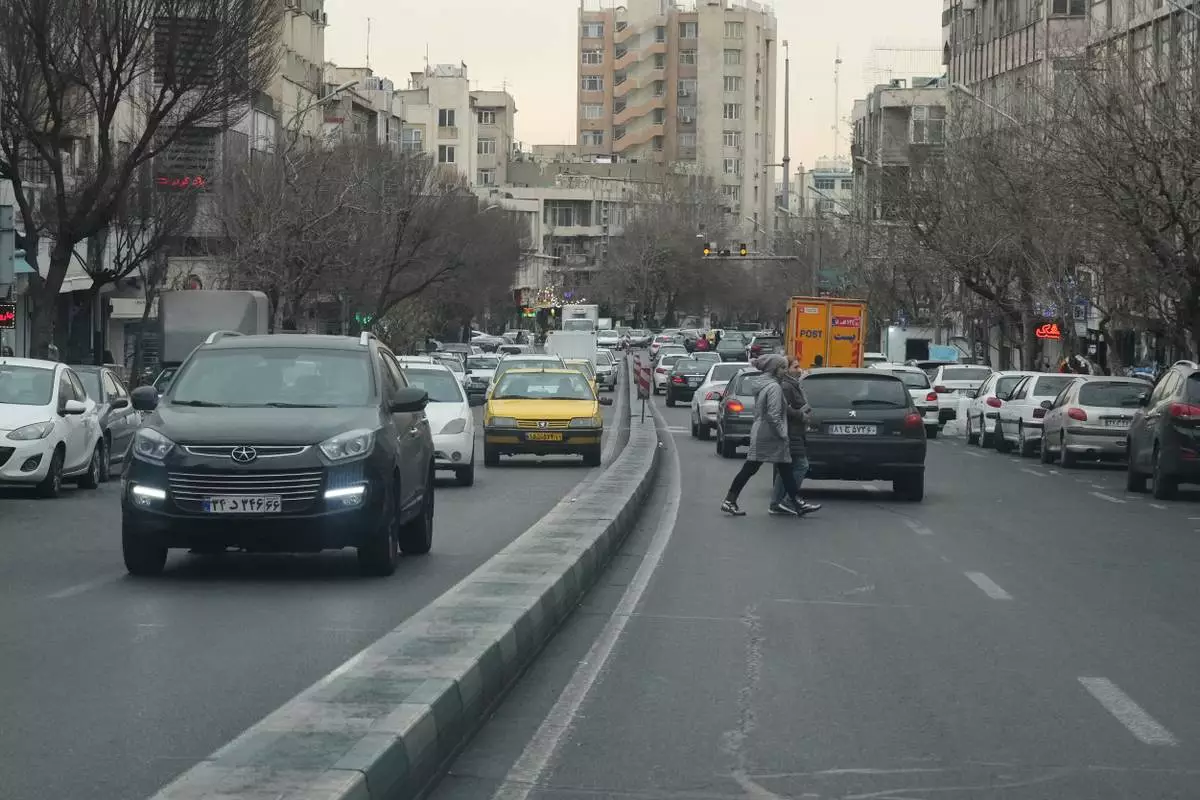
Vehicles drive on a street in downtown Tehran, Iran, Thursday, Jan. 15, 2026. (AP Photo/Vahid Salemi)
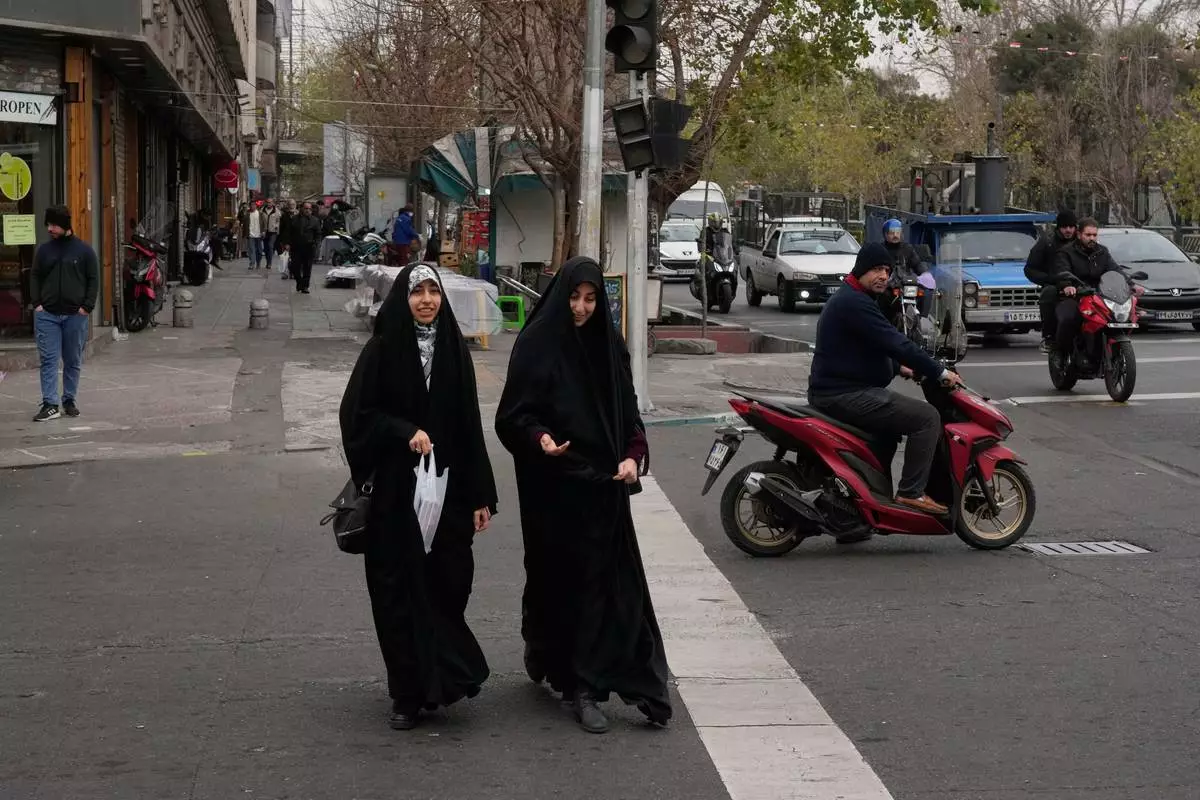
Women cross an intersection in downtown Tehran, Iran, Thursday, Jan. 15, 2026. (AP Photo/Vahid Salemi)
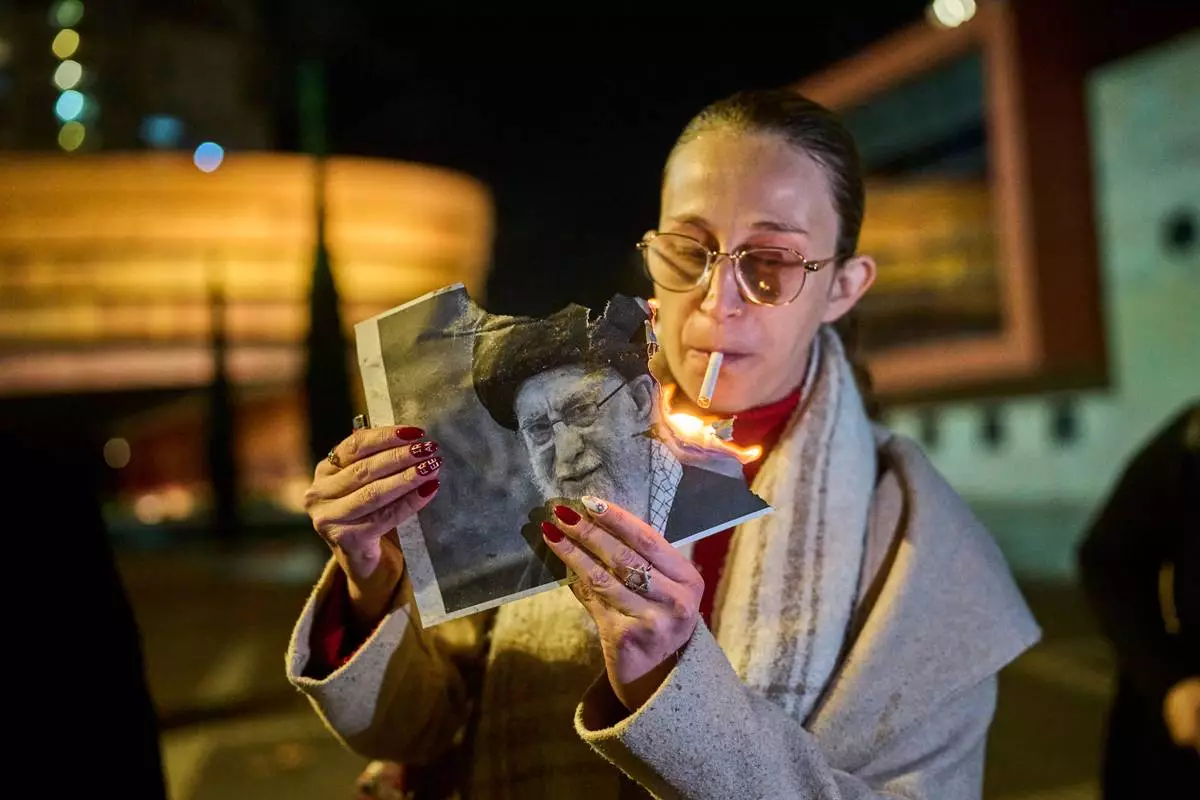
A demonstrator lights a cigarette with a burning poster depicting Supreme Leader Ayatollah Ali Khamenei during a rally in support of Iran's anti-government protests, in Holon, Israel, Wednesday, Jan. 14, 2026. (AP Photo/Ohad Zwigenberg)
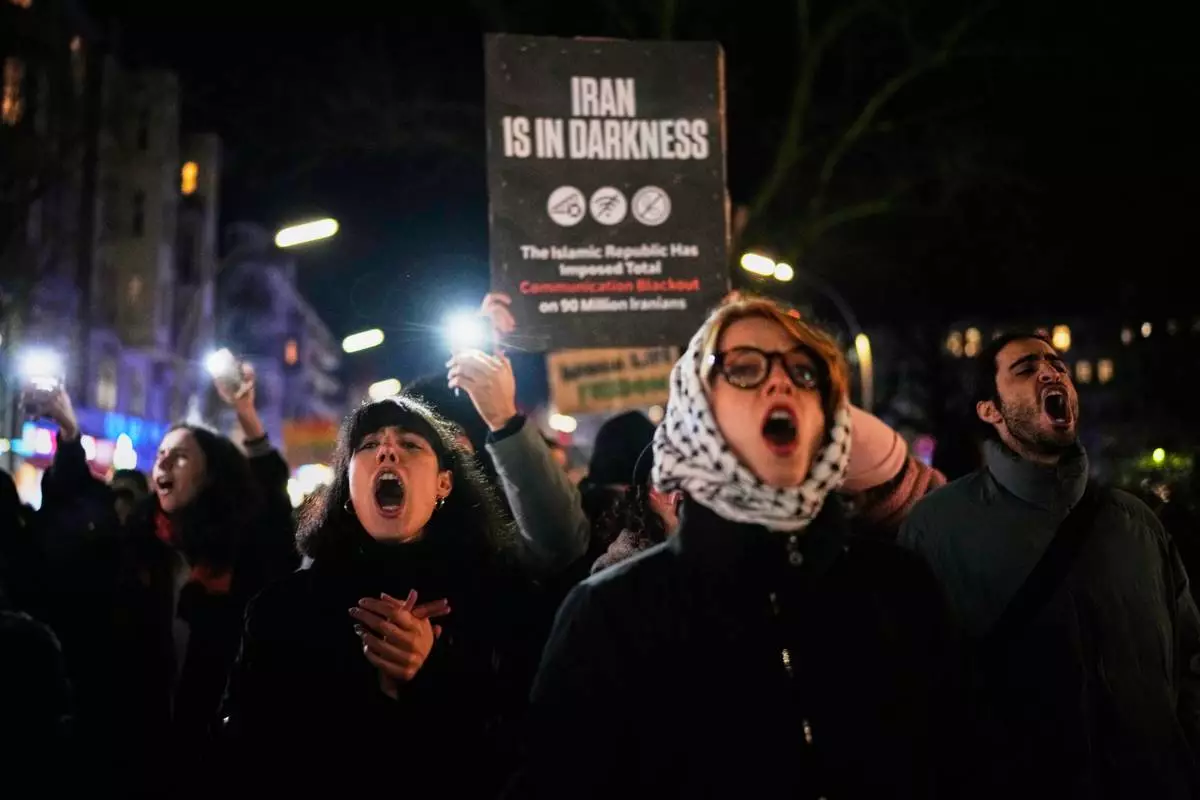
Protesters participate in a demonstration in support of the nationwide mass protests in Iran against the government, in Berlin, Germany, Wednesday, Jan. 14, 2026. (AP Photo/Ebrahim Noroozi)
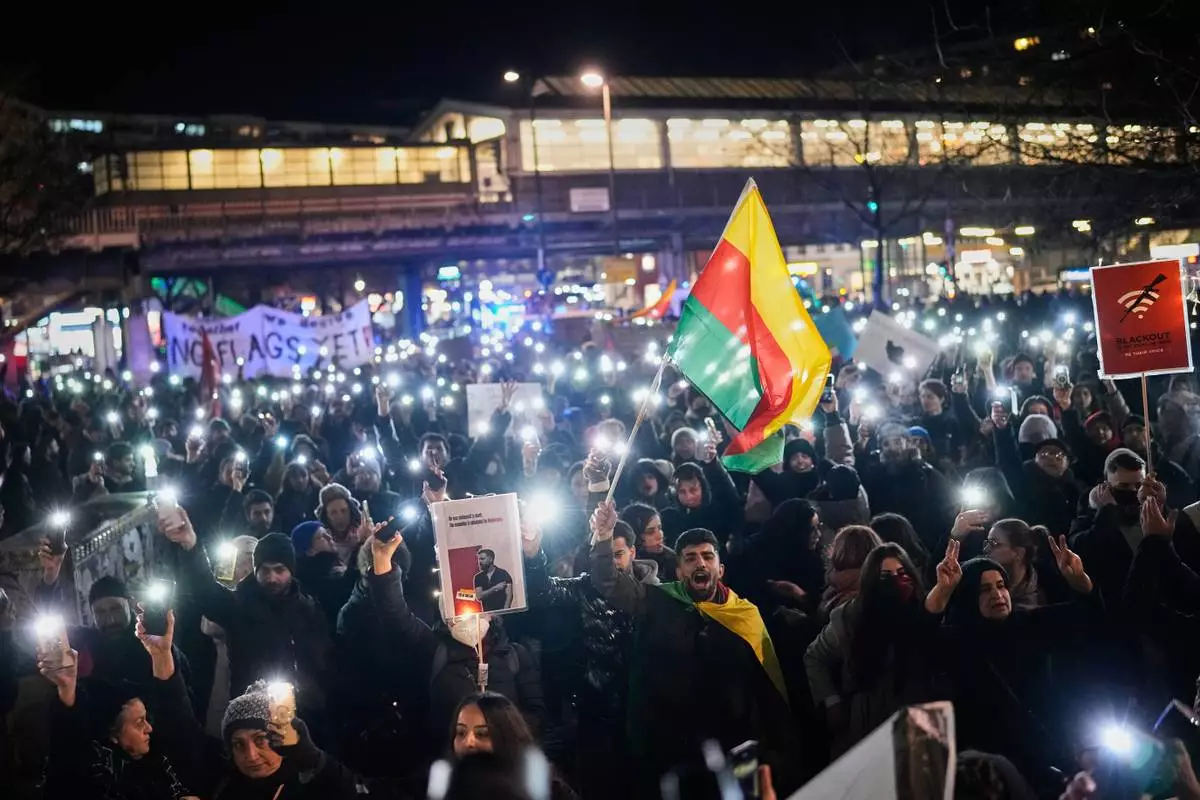
Protesters participate in a demonstration in support of the nationwide mass protests in Iran against the government, in Berlin, Germany, Wednesday, Jan. 14, 2026. (AP Photo/Ebrahim Noroozi)














